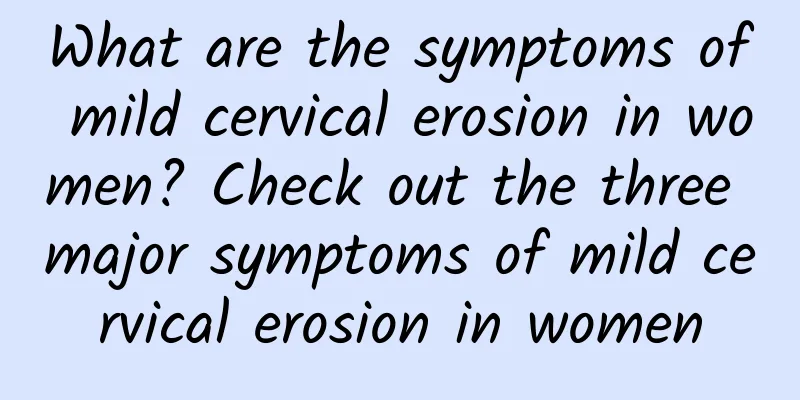What are the symptoms of cervical erosion? Women with cervical erosion will have three symptoms

|
Cervical erosion is a common gynecological disease. It is a manifestation of chronic inflammation. The larger the area of cervical erosion, the more likely the patient's condition will recur, and the recurrence rate after treatment is higher. Let's take a look at the symptoms of cervical erosion. Before treating the disease, we must first clearly understand the symptoms of cervical erosion. Here are its symptoms for everyone. Cervical erosion Most women will have varying degrees of cervical erosion after marriage. As the pregnancy progresses, the levels of estrogen and progesterone in the pregnant woman's body continue to increase, causing the columnar epithelium of the cervix to migrate outward, tissue hyperplasia, and cervical erosion symptoms to become significantly aggravated, which can easily lead to vaginal bleeding; excessive sexual activity, overeating hot and irritating foods such as chocolate, peppers, longans, or hot pot can also aggravate bleeding symptoms. 1. Increased leucorrhea Increased leucorrhea is the main symptom of cervical erosion, and sometimes even the only symptom. Due to the different pathogens, as well as the differences in the scope and degree of erosion, the characteristics of leucorrhea are also different. If the inflammation and infection are not obvious, the leucorrhea is mainly transparent mucus; if the cervical erosion is accompanied by obvious inflammation and infection, the leucorrhea is yellow purulent and viscous. If the erosion area is small or the lesion is shallow, the amount of leucorrhea may be small; if it is a severe erosion with a deeper lesion and a larger area, the amount of leucorrhea is large, and occasionally there may be a small amount of blood or blood. Some patients may sometimes complain of contact bleeding. 2. Pain: Pain symptoms of cervical erosion are rare. When the pathogens spread to a deeper area, it can cause chronic paracervical connective tissue inflammation, resulting in lumbar pain, pelvic pain and dysmenorrhea. If the inflammation spreads to the main ligament, sexual intercourse may be painful, affecting sexual life. 3. Bladder symptoms: Inflammation of the cervix can spread or directly spread to the bladder triangle, thereby stimulating the bladder and causing symptoms of frequent urination and painful urination, and sometimes secondary urinary tract infection. |
<<: What are the symptoms of cervicitis in women?
Recommend
What should I do if my daughter has irregular menstruation?
What should I do if my daughter has irregular men...
Fat woman loses 48kg in 9 months and becomes hot mom
"Miss, who are you?" This is the greeti...
What are the key points of home treatment for adnexitis?
In recent years, the prevalence of adnexitis has ...
Eat cucumbers, tomatoes and 7 other kinds of vegetables to lose weight and keep losing weight!
If you want to lose weight, vegetables are better...
Summary of the causes of atrophic vulvar leukoplakia
Atrophic vulvar leukoplakia is a relatively commo...
How to quickly relieve menstrual pain
Dysmenorrhea usually refers to abdominal pain or ...
You must learn to stay away from the causes of ectopic pregnancy!
If ectopic pregnancy is not treated in time, it w...
What are the symptoms of chronic pelvic inflammatory disease
What are the symptoms of chronic pelvic inflammat...
Will running cause abnormal vaginal discharge?
Running usually does not directly cause abnormal ...
How serious is the harm of pelvic effusion?
Pelvic effusion is pelvic fluid accumulation, whi...
What are the diagnostic tests for uterine fibroids?
Uterine fibroids are a common gynecological disea...
How to treat amenorrhea in women so that they can get pregnant
Amenorrhea affects pregnancy in women, and target...
What are the main sequelae of abortion?
Now many women know that the way to terminate pre...
How to cure chronic pelvic inflammatory disease
Chronic pelvic inflammatory disease (Pelvic infla...
Analysis of the main causes of moderate cervical erosion
It is understood that some patients with cervical...









